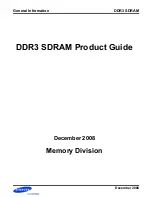
Bridge GUI Guide: Network Configuration
105
NOTE:
There is
only one VLAN
trunk per Bridge, used
by all
Trunk
ports. It is
defined by the Bridge’s
VLAN Active ID Table
Trunk
- configures the port to accept incoming packets
with any VLAN tag in the VLAN ID table and to send
packets with their VLAN tagging information
unchanged, including 802.1p priority tags, provided that
the port’s QoS override function is disabled (see
QoS
,
below).
Refer to Section 3.9 and to Table 3.14 for a complete
description of VLAN handling on the Bridge.
To support QoS, the Bridge treats incoming priority-tagged
packets (characterized by a VLAN ID of zero) as untagged
packets, but marks them for sorting into QoS priority queues
according to the user-priority value contained in their VLAN
tags. (Refer to Section 3.8 for details on the Bridge’s QoS
implementation).
You can configure VLAN port settings only in Advanced View.
3.7.7
Port QoS Setting
QoS
enables/disables the port’s Quality of Service override
feature. When enabled, the port’s QoS function forces all traffic
on the port into the specified QoS priority queue and adds a
priority marking for that queue to each packet. Bridge priority
markings replace any 802.1p Quality of Service (QoS) tags
included in the packets.
If a packet received on the port is transmitted wirelessly, the
Bridge uses the priority marking to determine its WMM (Wi-Fi
Multimedia) priority level. If the packet egresses over an
Ethernet port with a VLAN
Switching Mode
of
Trunk
(described
above), the Bridge priority marking is inserted into the packet’s
VLAN tag for QoS processing. (Ethernet ports with a
Switching
Mode
of
Access
do not send VLAN tags and so cannot include
priority tags.)
By default, the QoS override is set to
None
on all ports, which
disables the function. Alternatively, you can choose to
associate all traffic on the port with the Bridge’s
Low
,
Medium
,
High
or
Critical
priority queue. (Refer to Section 3.8 for more
information on QoS priority queues.)
You can configure QoS settings only in Advanced View.
3.7.8
Port Power over Ethernet
NOTE:
The ES520
can supply a maxi-
mum 36 Watts of PoE
overall and up to 16 W
per vertically stacked
port-pair, to connected
PDs. (Refer to the
ES520
Hardware Guide
for de-
tails.)
Only the ES520 Bridge can act as Power over Ethernet Power
Sourcing Equipment (PoE PSE), and only via the eight ports of
its internal LAN switch, labeled
lan1
–
lan8
in the Bridge GUI.
The
PSE
setting determines whether the port will serve PoE to
connected Powered Devices (PDs).
PSE
is
Disabled
by default.
It must be
Enabled
on every port through which you want to
supply PSE, i.e., on all ports connected to PDs.
















































